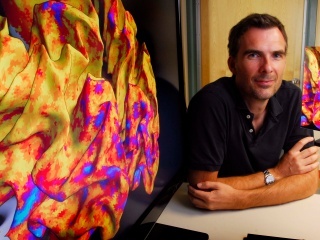Bioresearch can help the development of treatment for several eye diseases; for instance, the University of Illinois tackled macular degeneration and the University of Wisconsin developed solar contact lenses to treat the eye disease presbyopia. Now the University of Wisconsin, Madison is studying new solutions to the disease amblyopia, more commonly known as “lazy eye.”
Amblyopia is actually a brain disorder where the brain notices that one eye performs better than the other and then overcompensates for the difference. As Madison professor of neuroscience Bas Rokers (image below, courtesy University of Wisconsin) puts it, "The brain prefers the information from that eye, and pushes down the signal coming from the other, 'lazy' eye. In a way, it's better to think of the better eye as a bully, rather than the poorer eye as lazy."

(Madison professor of neuroscience Bas Rokers. Image courtesy University of Wisconsin)
Eventually, the brain ignores the input from the lazy eye, which causes the lazy eye to deliver even worse input. What Rokers and his team found is that in particular, the neural pathways from the brain to the eye degrade. Using a new brain scanning technique called diffusion-weighted imaging, they can see for the first time the damage caused by amblyopia. More excitingly for Rokers, they can now more accurately assess the progress of amblyopia treatments using periodic scanning.
Patients with amblyopia are usually treated with a combination of surgery and brain training. The former makes the lazy eye effective again, and the latter lets the brain know that it can begin using the eye again. This brain training is usually done by placing an eye patch over the previously dominant eye; however, this process takes a long time and is thought to only work on children.
"You don't see any adults walking around with patched eyes, because adults' brains are less plastic, less trainable, and we think the patch approach doesn't have any effect late in life," says Rokers in a recent University of Wisconsin press release. "But that belief is changing, and this diffusion-weighted imaging approach will help us understand whether, and how much, brain training treatments work."
Rokers looks forward to testing a slew of new amblyopia treatments, some of which involve video games and virtual reality headsets. These treatments might provide accelerated recovery that a child (or adult ) would find more enjoyable than spending days or weeks with an eye patch. Diffusion-weighted imaging will allow Rokers and ophthalmologists in general to determine the effectiveness of these ideas.
Dr. Rokers' research has been funded by the Wisconsin Alumni Research Foundation and the Netherlands Organization for Scientific Research. For further reading regarding funding for the University of Wisconsin, Madison and its studies, click on the link below.
Biotechnology Calendar, Inc. visits the University of Wisconsin campus for two of our BioResearch Product Faire™ events each year. We hold our Madison University Research Park BioResearch Product Faire™ and follow it up with our Madison BioResearch Product Faire™. For more information about these events, please follow their respective links. If you’re interested in attending a show closer to home, please look at our 2015 schedule of events to find a nationwide selection.


